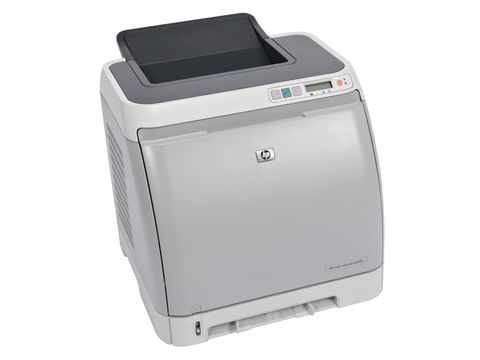TechRadar Verdict
You pay a little more up front, but this LaserJet will repay your investment in spades
Pros
- +
Economical in the long term
High-quality results
Built-in Ethernet
Cons
- -
Initial cost quite high
Why you can trust TechRadar
The latest in HP's long and illustrious history of LaserJet printers, the new 2600n nevertheless bears more than a passing resemblance to Canon's LBP-5000.
As well as having almost identical dimensions and styling, it also has a similar inline toner cartridge arrangement and, with no clunky carousel churning around, it's remarkably quiet in operation.
Imaging drums are built into the toner cartridges and there are no other ongoing supplies required, negating any nasty surprises or additional complexity in long-term running costs and maintenance.
Yet another similarity between the HP and Canon is the option of an additional, 250-sheet paper input tray, along with the standard 250-sheet unit, plus a manual feed tray for specialist media and envelopes.
The most notable difference between the two models is that the HP features a fast Ethernet connection as standard, rather than it being an optional extra, along with a more generous 16MB of built-in memory that's more suited to its network aspirations. The simple set-up procedure naturally gives you options for installing the printer as a directly connected or network device.
The 2600n also features a rudimentary display LCD status panel and onboard controls, which are lacking on the Canon. These are handy for making full use of set-up and printing options, as well as for keeping an eye on the status of the printer itself and its supplies.
Colour up
For graphics printing and photos the HP delivered striking colour in our tests, with many colours appearing slightly brighter and more vibrant than those from much of the competition. In some cases, colour from some of the other prints looked a little muddy by comparison, although the HP still produced accurate skin tones and rich, dark colours when required.
Sharpness proved excellent in small font edges for both mono and colour text, while fine detail in photos was superb, amply demonstrating the benefits of HP's PhotoREt 2,400 resolution enhancement technology.
The trade-off is that, compared with the Canon, the HP proved consistently a second or two slower for mono or colour document pages and as much as six seconds slower for A4 photo prints. For our money, however, the noticeably higher print quality is more than worth the slight extra wait.
In the longer term, the HP is especially good news for low to average print volume users. This is because you don't need to buy a set of high-yield print cartridges (which often cost double the purchase cost of the printer itself) to be able to take advantage of the 2600n's competitive toner costs.
This is even more remarkable when you consider the toner cartridges' built-in imaging drums that we mentioned earlier. Sure, the HP isn't the cheapest to buy, but with its excellent print quality, ease of use, cheap running costs and built-in Ethernet networking, it ticks all the right boxes and you'd be hard-pressed to find a home or small office to which it wasn't ideally suited.
Tech.co.uk was the former name of TechRadar.com. Its staff were at the forefront of the digital publishing revolution, and spearheaded the move to bring consumer technology journalism to its natural home – online. Many of the current TechRadar staff started life a Tech.co.uk staff writer, covering everything from the emerging smartphone market to the evolving market of personal computers. Think of it as the building blocks of the TechRadar you love today.

